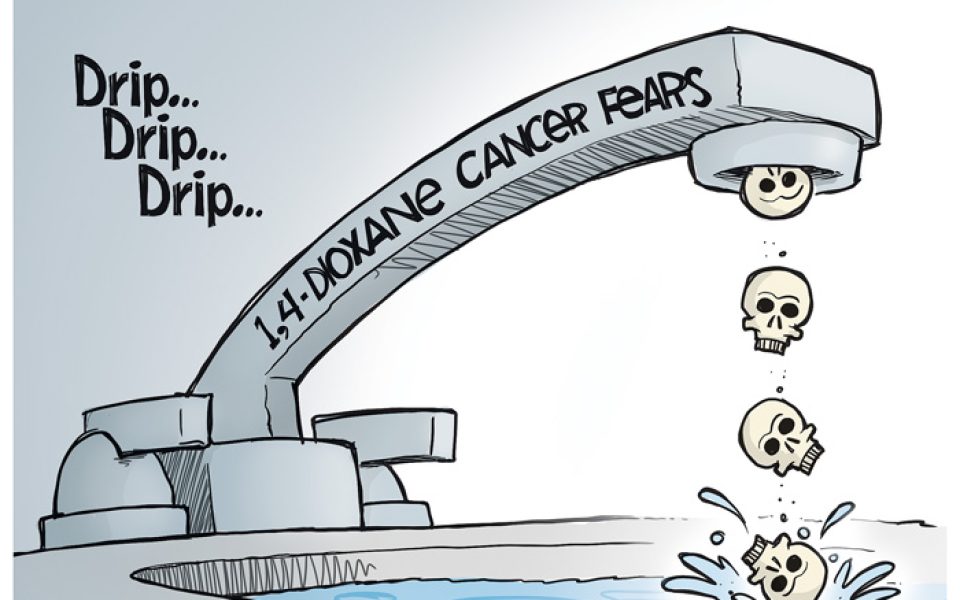Note: This piece was originally published by NC Policy Watch on Nov. 9. Story by Lisa Sorg.
Greensboro’s wastewater treatment plant illegally discharged high levels of the likely carcinogen 1,4-Dioxane into the Haw River, the drinking water supply for the Town of Pittsboro and other downstream communities along the Cape Fear River.
Adam Pickett, Pittsboro’s public utilities director, confirmed to Policy Watch that there had been a discharge. Emails obtained by Policy Watch show that the discharge occurred on Nov. 3, and Greensboro notified downstream communities, including Pittsboro, on Nov. 8. The amount of 1,4-Dioxane in the original discharge was 767 parts per billion; that’s more than 2,100 times the EPA’s and the state’s health advisory goal for surface water.
The discharge violates the terms of a Special Order by Consent between DEQ and the City of Greensboro, which set a maximum daily level of 45 parts per billion of 1,4-Dioxane in wastewater. The Haw River Assembly, represented by the Southern Environmental Law Center, has challenged the terms of the order, saying they are not protective enough. Haw Riverkeeper Emily Sutton told Policy Watch that Greensboro had not contacted the group directly about the latest discharge, “even as negotiations are underway regarding the Special Order by Consent triggered by major 1,4- dioxane releases” that occurred in 2019 and 2021.
1,4-Dioxane is a toxic chemical used in degreasers that the EPA has classified as a likely carcinogen. There is no regulatory standard for 1,4-Dioxane, but the EPA has set a health advisory goal of 35 parts per billion for drinking water, which equals a 1-in-10,000 lifetime excess cancer risk. The surface water goal is more stringent, at 0.35 ppb, a 1-in-1 million lifetime excess cancer risk.
Emails show that Pittsboro’s latest sampling through Nov. 2 showed levels of 4 parts per billion. It’s still unknown how much 1,4-Dioxane entered the town’s drinking water, but results should be available this afternoon.

Elijah Williams, water reclamation manager for the City of Greensboro, told Policy Watch that utilities staff has notified the NC Department of Environmental Quality (NCDEQ) and downstream utilities and is actively investigating possible sources of the substance.
This is just one of several illegal discharges from the Greensboro plant. The most recent one occurred in July 2021; sampling results showed that levels from in wastewater ranged from 543 parts per billion to 687 parts per billion. Greensboro officials said they had not identified the source.
In August 2019, Greensboro’s discharge contained levels of 1,4-Dioxane ranging from 705 ppb to 1,210 ppb. The source of the contamination was Shamrock Environmental, an industrial customer that discharges its wastewater to the Osborne plant.
The TZ Osborne Wastewater Treatment Plant in Greensboro receives discharges from both residential and industrial customers in Guilford County. From there, the plant treats the discharge before sending it into South Buffalo Creek, which feeds the Haw. However, conventional treatment systems don’t remove 1,4-Dioxane.
Join the First Amendment Society, a membership that goes directly to funding TCB‘s newsroom.
We believe that reporting can save the world.
The TCB First Amendment Society recognizes the vital role of a free, unfettered press with a bundling of local experiences designed to build community, and unique engagements with our newsroom that will help you understand, and shape, local journalism’s critical role in uplifting the people in our cities.
All revenue goes directly into the newsroom as reporters’ salaries and freelance commissions.


…a couple of things:
-I respectfully submit you look up “illegal discharge” in the NCGS.
-nowhere in any statute is notification to the Haw River Alliance required for anything.
@slob
~I looked up “respectful” and it said not to pollute peoples drinking water with carcinogens.
~I checked all the NC statutes and they were mostly ways to protect the money man.